Nature’s mesmerizing dancers, hummingbirds, are always in search of the sweetest nectar to feed their energetic flights. Of all the flowers they can visit, one flower that often catches their eye is the mandevilla, a vining plant with stunning trumpet-like blooms — perfect for these tiny, fluttering birds. But are you thinking about attracting hummingbirds to your garden? If so, how can you make your garden a go-to spot for these tiny birds?
Alongside mandevilla, there are a number of flowers that hummingbirds simply can’t resist. In this article, we will explore some of the best flowers to plant in your garden to attract hummingbirds, including mandevilla. We will also offer tips for nurturing this plant to make the most of it. Let’s get started!
Do Hummingbirds Like Mandevilla?
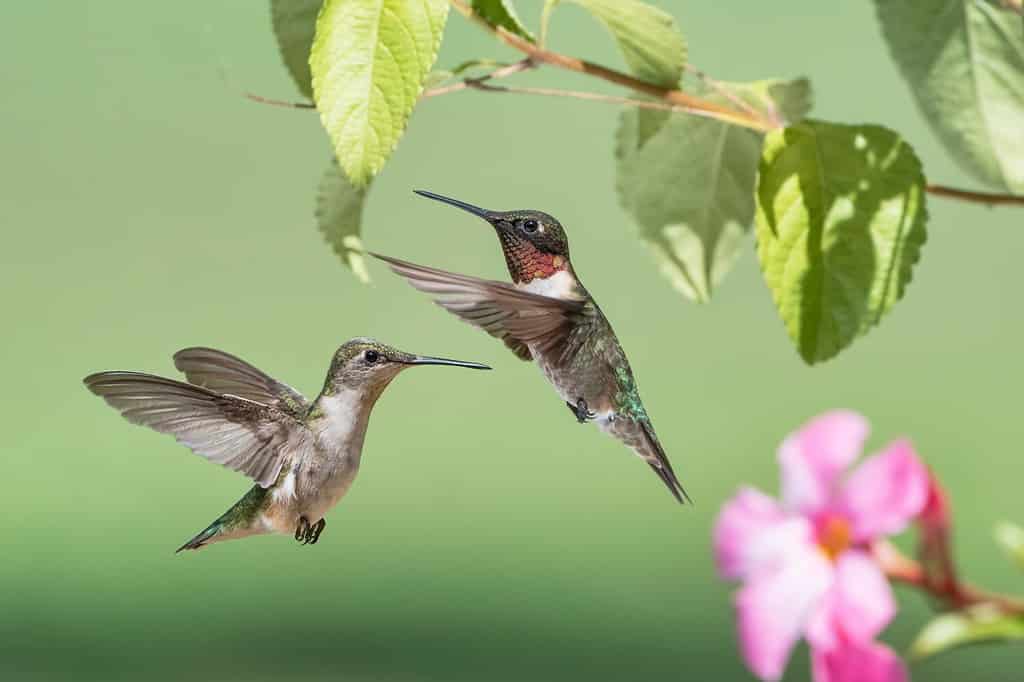
Yes, hummingbirds love mandevilla, thanks to their rich nectar and trumpet-like flower structure.
©Bonnie Taylor Barry/Shutterstock.com
Hummingbirds, the tiny birds native to the Americas, are lighter than a coin, making them the smallest birds around. These delicate creatures possess elongated beaks and remarkably swift wings, which let them remain suspended in the air or even navigate in reverse. It’s astounding that their wings can move at a speed of around 80 flaps per second. Drawn to the sweetness of nectar and the charm of vivid blossoms, they also consume tiny insects.
The mandevilla plant, known for its rich colors and inviting aroma, is especially enticing to hummingbirds. Its trumpet-like, tubular flowers seem tailor-made for the bird’s lengthy beak and tongue. Often seen as a cornerstone in tropical gardens, the mandevilla’s rapid growth and captivating fragrance are hard for hummingbirds to resist.
The key attraction for hummingbirds is the mandevilla’s flower structure. Shaped almost like a trumpet, it offers easy access for these birds to delve deep and extract the nectar. Given the hummingbird’s nectar-centric diet and their high energy needs, the mandevilla becomes an ideal pitstop.
This unique bond between the hummingbird and the mandevilla is mutually advantageous. While the bird gets to enjoy a rich source of nectar, the mandevilla benefits as the hummingbird aids in its pollination.
So, to answer the query, “Do Hummingbirds Like Mandevilla?” — Absolutely! In fact, they adore it!
How to Grow Mandevilla
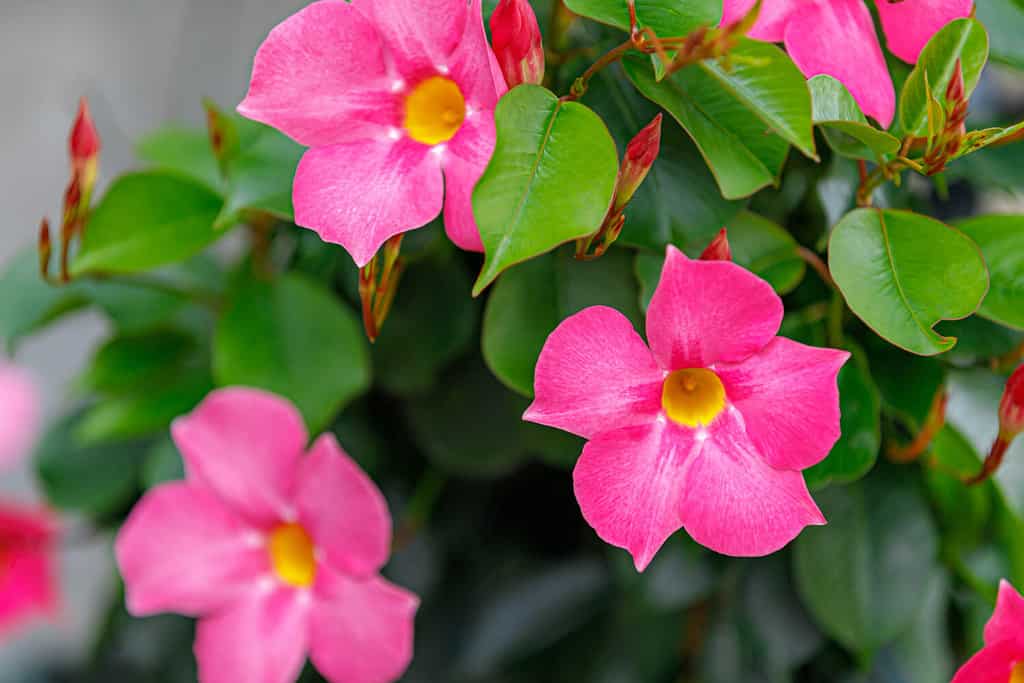
To grow mandevilla, ideally plant them in USDA hardiness zones 9 to 11.
©Wut_Moppie/Shutterstock.com
Mandevilla is an exotic plant native to the Southwestern United States, and it’s known to be a magnet for hummingbirds. Typically, gardeners plant mandevilla vines in pots supported by trellises, treating them as seasonal blooms.
If you reside in the southernmost parts of the U.S., particularly in USDA zones 9 to 11, mandevilla can brave the winter outdoors.
However, for those living in more moderate northern climates, mandevilla requires a sunny, protected spot outdoors during the balmy summer days. To ensure its longevity beyond the summer, it’s essential to relocate the plant to an indoor setting or a protected area during the colder months.
Ideally, mandevilla thrives in regions boasting tropical or subtropical conditions characterized by intense warmth, absence of frost, and moderate humidity. If your locale doesn’t naturally offer these conditions, be prepared to put in some extra effort to see your mandevilla flourish.
Essential Mandevilla Facts
In order to successfully grow your mandevilla and see the plant flourish, you need to learn about it and get to know it. So, here are some essential facts about this beautiful flower.
Size
Typically, a mandevilla can be a sprawling vine or exhibit a bushier presence. Its height can range from a modest 1 foot to a towering 20 feet, spreading anywhere from 1 to 15 feet across.
Flowering Season
This plant flowers from late spring until the cooler fall months, and in areas free from frost, it can bloom almost throughout the year!
Appearance
Recognized for its rapid growth, this tropical vine showcases aromatic flowers, each flaunting five petals in colors ranging from soft pinks and pure whites to vibrant reds and yellows. Some even have a contrasting yellow center.
Complementing these blossoms are its lustrous, oval green leaves which can measure between 2 to 8 inches in length. Their texture can vary from silky smooth to slightly leathery. While traditional mandevillas are climbers needing support, recent cultivars are designed to have a more bush-like structure.
Safety Concerns
Handle this plant with care! Mandevilla can be harmful if ingested, especially by pets or kids. Additionally, when cut, they ooze sap that might irritate the skin. Make sure to keep this plant out of reach of kids and your furry friends!
Deer Tolerance
While mandevilla is usually not a deer’s first choice for a snack, in situations where food is limited, these plants might see some nibbling. But generally, this plant is considered both deer and rabbit-resistant, thanks to its toxic properties.
Mandevilla Growing Guide
So, how do you grow mandevilla?
Ideal Planting Time
Spring is the best time to plant mandevilla, once the soil becomes warm and the threat of frost vanishes. If you live in a cooler region outside the plant’s comfort zone, it’s advisable to plant when nighttime temperatures consistently stay above 50 degrees Fahrenheit. In cooler climates, you might even need a greenhouse or cold frames to nurture the plant outdoors.
Soil
Mandevilla isn’t too picky when it comes to soil, but it does its best in nutrient-rich soil that isn’t water-retentive. Enriching the ground with compost or organic matter can provide this balance. If planting in containers, blend a high-quality potting mix with some peat moss or sand for optimum results.
Fertilizer
Mandevilla loves to be fed regularly. Opt for a balanced fertilizer tailored for decorative plants. For stunning blossoms, lean towards fertilizers with a bit more phosphorus. Start feeding the plant in spring and continue every fortnight until the middle of summer.
Watering Needs
Keep the soil around the mandevilla plant consistently damp but never waterlogged or soggy. While this plant might not always need extra watering, drier regions might call for it. If you’re cultivating mandevilla indoors, occasional spritzing can help maintain the right humidity.
Sunlight Requirements
Sun-loving by nature, mandevilla blossoms best with ample sunlight — with at least 6 to 8 hours of direct sun for best flowering. Partial shade is tolerable, but for a flourishing vine, prioritize direct sunlight. If placed in containers or particularly hot regions, a bit of shade during the hottest afternoon hours can be beneficial to prevent the dreaded leaf scorch.
Providing Support
Since mandevilla is naturally a climbing plant, it needs support to flourish. Equip your plant with a trellis or a similar structure to guide its growth and help it thrive.
Addressing Potential Issues
Mandevilla can sometimes fall prey to pests like mealybugs, whiteflies, or mites, especially when kept indoors. Additionally, they can be susceptible to leaf diseases, such as Anthracnose, which manifests as spots on leaves and can cause yellowing or early leaf drop.
Alternative Flowers That Attract Hummingbirds
Although mandevilla is a favorite among hummingbirds, there are plenty of other plants that can entice these magnificent birds into your garden. Let’s dive into some wonderful choices that are bound to captivate and draw hummingbirds to your outdoor space!
1. Anisse Hyssop (Agastache foeniculum)
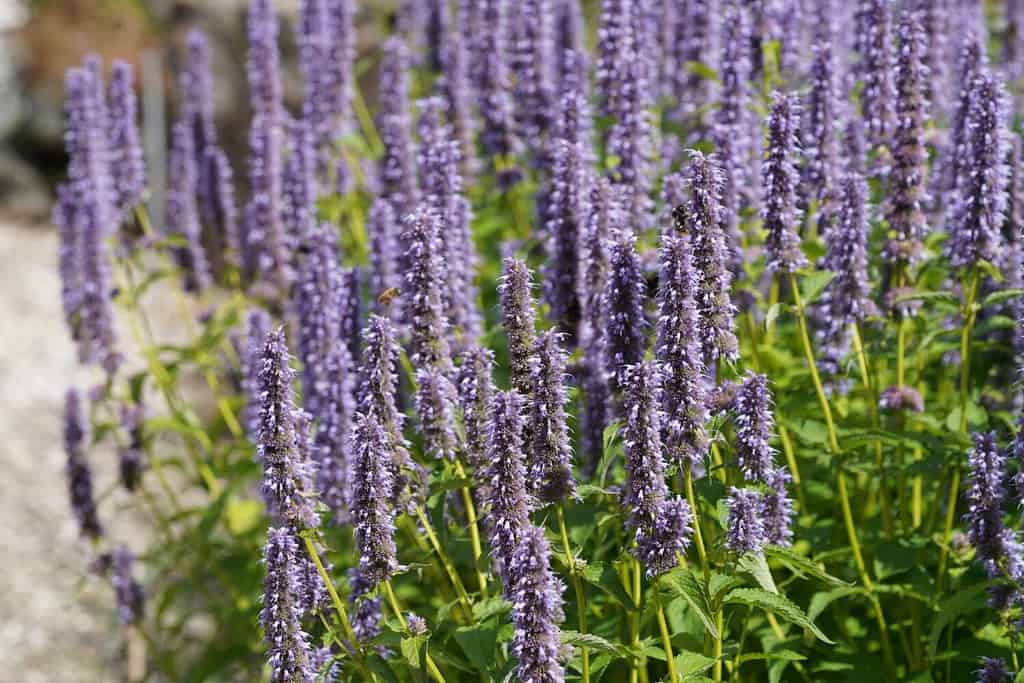
As its name suggests, the leaves of the anise hyssop plant smell like anise.
©Doikanoy/Shutterstock.com
Anise hyssop is a perennial that stands tall, forming clusters and showcasing spikes filled with small, tubular flowers that range from lavender to purple hues. These blooms grace gardens from the beginning of summer until early fall. These flower spikes aren’t just eye-catching; they’re also a magnet for bees, hummingbirds (of course!), butterflies, and other helpful insects.
The plant boasts sturdy stems with a square shape, adorned with oval, green leaves that have a unique toothed pattern and can grow up to 4 inches long. A distinguishing feature of the anise hyssop is its aromatic leaves, which release a delightful anise fragrance when touched.
This plant shines in relaxed settings, herb gardens, butterfly havens, or even wild meadows.
Anise hyssop thrives under full sunlight to partial shade and prefers average soil conditions that are well-drained, ranging from dry to moderately moist. Once the plant settles in, it exhibits drought resistance. Suitable for gardens in USDA zones 4 through 8, anise hyssop is a resilient option for gardens.
One of its standout features is its prolonged bloom period bursting with vibrant shades, ensuring a steady visit from hummingbirds and various bee species to your outdoor space. If you’re looking to diversify the plants that draw hummingbirds, anise hyssop is a top pick!
2. Purple Sage (Salvia leucophylla)
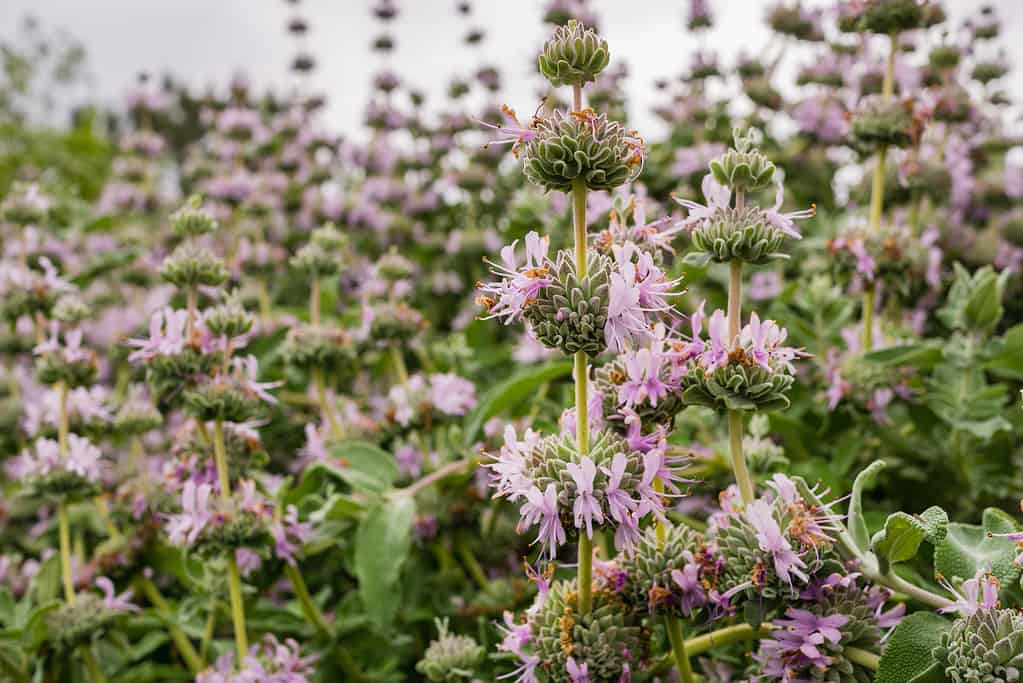
Another favorite flower of hummingbirds is the purple sage.
©Sundry Photography/iStock via Getty Images
Purple sage stands out as a perennial favorite, bursting with vibrant violet blossoms from mid-summer until the first frost. Displayed in loose clusters on upright stems, these blossoms are accompanied by aromatic dark green leaves. The combination not only brings visual attraction to gardens and borders but is also a magnet for butterflies and hummingbirds. Typically reaching heights between 12-18 inches and spreading about 24-30 inches wide, purple sage is both compact and impressive.
This plant is happiest basking in the full sun, planted in soils that are well-drained and range from dry to medium. Although it flourishes with generous sunlight, it’s forgiving enough to tolerate some light shade. Once settled into its environment, this perennial demonstrates commendable drought resistance.
If you’re seeking low-maintenance plants to attract hummingbirds, purple sage is an excellent choice, fitting seamlessly into flower beds, borders, or even pots. For those situated in USDA zones 5 through 9, this sage is an ideal pick.
A noteworthy attribute of the Salvia sage family is their high nectar content, which is a must-have for hummingbirds. Incorporating any Salvia sage variety into your garden will satiate these birds’ nectar cravings. However, there’s something about the color purple that especially entices these winged wonders, making purple sage a perfect choice for hummingbird enthusiasts!
3. False Sunflower (Heliopsis helianthoides)

To attract hummingbirds to your garden, try planting false sunflowers.
©Alex Manders/Shutterstock.com
The false sunflower is a radiant, albeit short-lived perennial, casting a display of sun-like blossoms from the start of summer to its close. Each flower, spanning 2-3 inches, is framed with vibrant yellow-orange petals encircling a cone-like, brownish-yellow heart. Sporting pairs of toothed, ovate leaves that measure around 6 inches, the stems of this perennial rise with grace and sturdiness. Its array of dazzling daisies that glow for an extended season makes the false sunflower a cherished asset in gardens. What’s even better? This beauty doesn’t ask for much, offering striking midsummer hues without demanding extensive care.
Optimally, the false sunflower thrives under the generous light of full sun, rooted in average soils that range from dry to medium. Versatility is one of its strong suits, as it adapts to a variety of soil types – be it impoverished, clay, or dry. Although this plant can manage in some light shade, such conditions may cause it to lean, possibly needing support.
The false sunflower is best suited for those in USDA zones 3 through 9.
Hummingbirds are especially attracted to this plant because of the colorful flowers!
4. Cardinal Flower (Lobelia cardinalis)
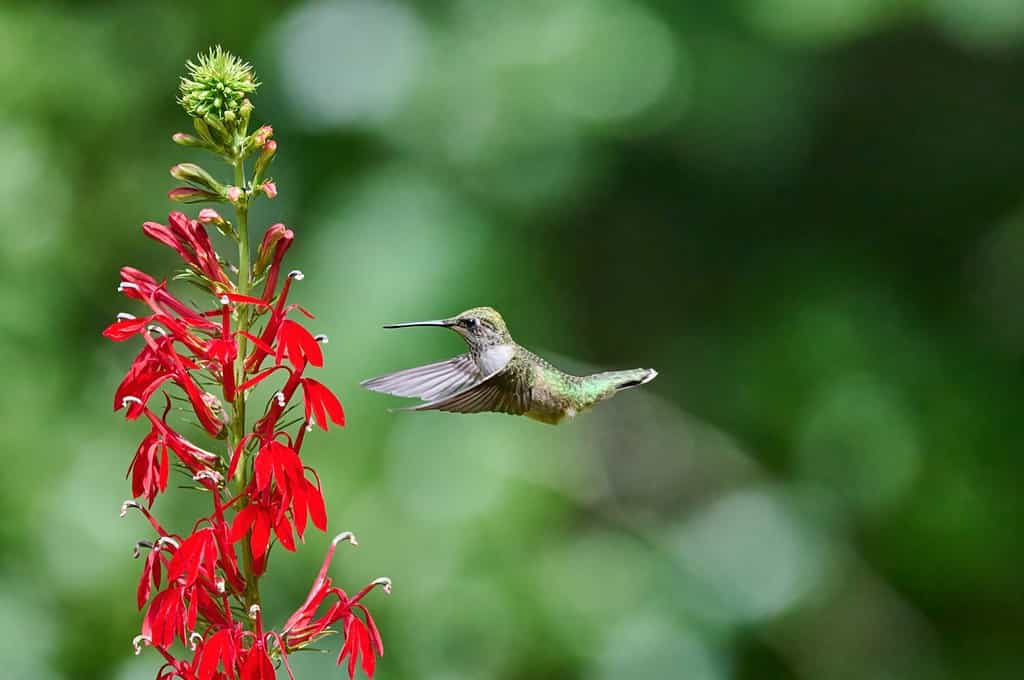
Ruby-throated hummingbirds love cardinal flowers.
©Patrick Jennings/Shutterstock.com
The cardinal flower is for those wanting to spice up their late-summer gardens. This tall perennial bursts into life with stunning spikes of bright red flowers from midsummer until the early fall. These red beauties rise from a base of shiny green leaves, adding a touch of vertical flair to any garden space. Not only is it a sturdy plant that doesn’t need much care, but it’s also resistant to most pests and diseases. It’s even earned a top award from the Royal Horticultural Society.
For best growth, plant it in moist soil that’s either in full sunlight or partially shaded. It’s even okay if the soil is a bit wet or poorly drained. In fact, the cardinal flower can thrive in water up to 3 inches deep!
If you’re aiming to attract hummingbirds, this flower is a must-have. Especially from mid-August to October, it serves as a favorite nectar source for the ruby-throated hummingbird. So, if you’re exploring alternative flowers to lure these delightful birds, the cardinal flower is a top contender.
5. Fire Pink (Silene virginica)
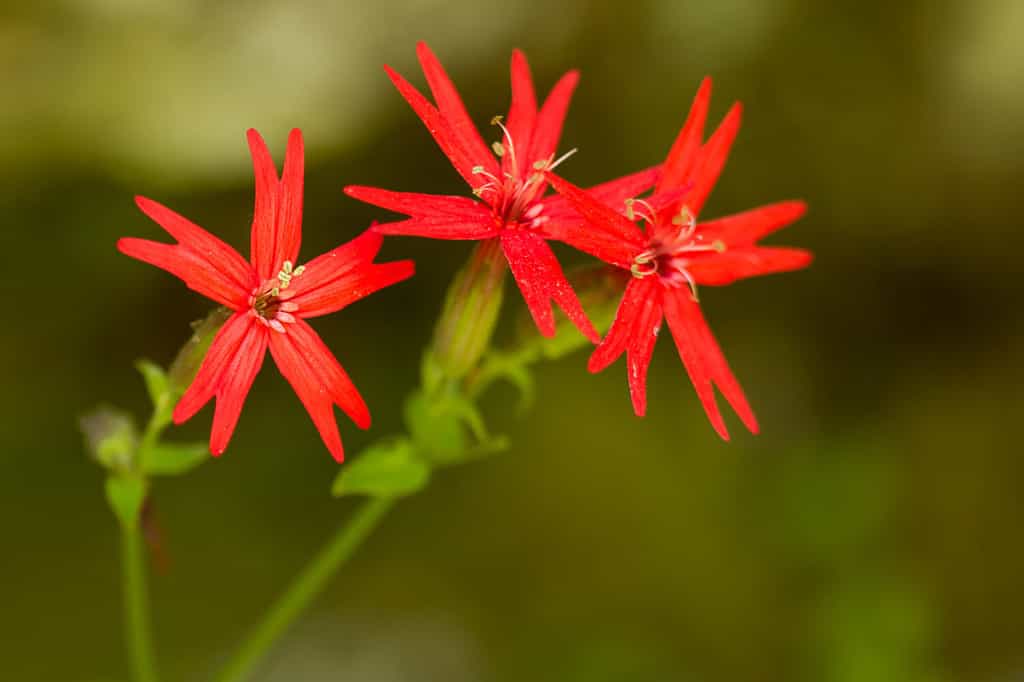
Another favorite of the
ruby-throated hummingbird
is the fire pink flower.
©Agnieszka Bacal/Shutterstock.com
The fire pink captivates with its intense red blossoms, evoking the warmth of glowing coals. This perennial flourishes in clumps with long, slender leaves and clusters of scarlet flowers that come alive from mid-spring to early summer. Each blossom is unique, with five slim petals that have a slight split at the tips.
These flowers sit atop thin stems and are a magnet for hummingbirds and butterflies, thanks to their rich pollen content. While the fire pink might not last forever in your garden, it has a chance to naturally reseed itself under the right conditions. This wildflower is a picture-perfect choice for shaded rock gardens, wildflower collections, or even the cozy corners of a cottage garden.
For the best growth, find a spot that’s partly shaded with well-draining soil that’s moderately fertile. While it can handle some full sun exposure, it’s happiest when shielded from the harsh afternoon rays.
If you’re in zones 4 to 8, this plant is ideal for your garden. And if you’re aiming to draw in ruby-throated hummingbirds, the fire pink should be on your list. They love it, making it another great flower choice to bring these delightful birds closer to home.
Summary of Flowers Hummingbirds Love
| Flower | Botanical Name |
|---|---|
| Mandevilla | Mandevilla |
| Anise Hyssop | Agastache foeniculum |
| Purple Sage | Salvia leucophylla |
| False Sunflower | Heliopsis helianthoides |
| Cardinal Flower | Lobelia cardinalis |
| Fire Pink | Silene virginica |
The photo featured at the top of this post is © Bonnie Taylor Barry/Shutterstock.com
Thank you for reading! Have some feedback for us? Contact the AZ Animals editorial team.







